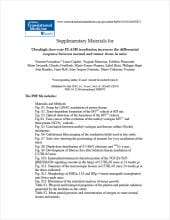Background
Pulsed irradiation (FLASH) was performed using the 4.5 MeV linear electron accelerator (LINAC) described in (34). The system allows exposure of cells or animals to a single sub-microsecond pulse, to any sequence of pulses, or to split-dose irradiation with an interval between fractions ranging from fractions of seconds to a few minutes.
The LINAC was operated by a computer via an interface designed and built by EuroMeV and PMB-Alcen, allowing a full control of the triggering, pulse width and sequences, beam current, delays and repeat frequency (Table S1). The dose per pulse was set by adjusting the beam current, the pulse width and the distance to the beam output window. The pulse to pulse repeatability was better than 3%.
Material & Methods
Beam collimation for irradiation of the mouse thorax (Fig. S1) was achieved by means of two 22 mm-thick beam-limiting graphite plates (Schunk Electrographite). Real-time measurement of the electron pulses was made by detecting the current generated by electrons trapped in the primary graphite collimator located close to the electron beam output and grounded through a 25 or 50 resistor. The signal was sent through a coaxial cable to a NI PXI-1033 digitizer with 5105 and 5152 amplifiers (National Instruments). The software operating the PXI-1033 digitizer and allowing automated capture, storage and integration of transient pulses was designed by EuroMeV and PMB-Alcen.
Results
At 3 weeks, i.e. at the peak of the reactions, a grade 1 epithelitis (CTCAE v 5.0) along with a transient grade 1 oedema (CTCAE v5.0) in soft tissues surrounding the tumor were observed. Clinical examination was consistent with the optical coherence tomography showing no decrease of the thickness of the epidermis and no disruption at the basal membrane with limited increase of the vascularization. In parallel, the tumor response was rapid, complete, and durable with a short follow-up of 5 months. These observations, both on normal skin and on the tumor, were promising and prompt to further clinical evaluation of FLASH-RT.
Conclusion
In conclusion, CONV and FLASH irradiation are equally effective in regard to log(RTV) values (pβ1CONV – β1FLASH > 0.8844) for α = 0.05.
